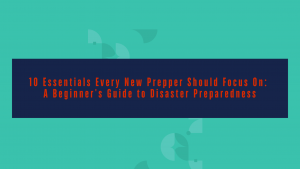
Let’s talk basics.
If you’re an experienced prepper, you probably have all of these covered. But if you’re a new prepper, then these are the areas you need to focus on first.
The journey into disaster preparedness can be overwhelming, but focusing on a few essential areas can make the process less daunting.
Starting with essentials like food, water, and shelter, and expanding to include tools, first aid supplies, communication, and reliable sources of light and warmth, this article outlines ten key areas every prepper should cover.
1. Communication
In a major disaster, communication systems will likely go down. Cell phones may not function, and landlines could be down as well. You’ll need to have a way to find out what is happening beyond your four walls. Knowledge is power. You’ll also want to reach out to loved ones.
- Battery-powered or hand-crank radio to receive emergency broadcasts and updates.
- Solar-powered charger to keep your electronic devices powered.
- Quality two-way radios for staying in contact with family members if you need to separate for supplies or information.
Ensuring you have enough food to sustain you and your family during an emergency is crucial.
- Non-perishable food items such as canned goods, dried fruits, nuts, and grains.
- Freeze-dried meals that are lightweight and have a long shelf life.
- Manual can opener in case of power outages.
Water is vital for survival, and having a plan for water storage and purification is essential.
- Stored water, aiming for at least one gallon per person per day.
- Water purification tablets to make any water source safe to drink.
- Portable water filter for filtering water on the go.
4. Shelter
Having a safe place to stay during a disaster is critical.
- Tent or tarp in case you need to evacuate and can’t find shelter.
- Warm clothing and blankets to stay warm in case of power outages.
- Multi-tool for setting up shelter and other survival needs.
A comprehensive first aid kit can be a lifesaver in an emergency.
- First aid manual to guide you through emergency medical situations.
- Basic medical supplies including bandages, antiseptics, pain relievers, and any necessary prescription medications.
- CPR face shield and gloves for safety when providing first aid.
6. Tools
Having the right tools can make a significant difference in your ability to survive and adapt.
- Multi-tool that is compact and useful for a variety of tasks.
- Survival knife essential for cutting, preparing food, and protection.
- Duct tape and paracord as versatile items for repairs and building.
7. Light and Warmth
Maintaining light and warmth is crucial, especially if you are stranded without power.
- Flashlights and lanterns with extra batteries or solar-powered options.
- Emergency candles and matches for backup lighting.
- Hand warmers and emergency blankets to retain body heat.
8. Hygiene
Maintaining hygiene can prevent illness and keep you comfortable during an emergency.
- Personal hygiene items such as toothbrush, toothpaste, soap, and sanitary supplies.
- Hand sanitizer and wet wipes for quick cleaning without water.
- Portable toilet for sanitary needs if plumbing is unavailable.
9. Clothing
Appropriate clothing can protect you from the elements and keep you comfortable.
- Sturdy, weather-appropriate clothing including waterproof outerwear.
- Sturdy footwear for protection and comfort.
- Extra socks and underwear to stay dry and hygienic.
10. Self-Defense
Being prepared to protect yourself and your family is essential.
- Self-defense training with knowledge of basic self-defense techniques.
- Pepper spray or similar non-lethal options for personal protection.
- Secure storage for any weapons you may legally own and know how to use.
By focusing on these ten key areas, you can create a solid foundation for disaster preparedness. Start with the basics, build your supplies and skills over time, and ensure you and your loved ones are ready for any situation.
You can find these items at
www.Prep2Survive.com or on
Amazon

